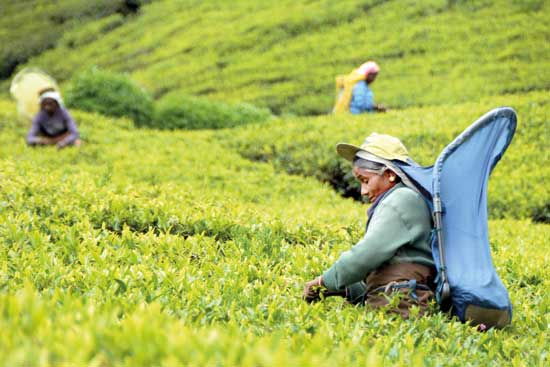Industrialisation revisited: Sri Lanka’s recovery and progress
View(s):Recovery and beyond
I decided to share with you today, the importance of the role of industrialisation as a medium-term strategy for both economic recovery and economic progress of the crisis-ridden Sri Lanka. For two years now, the country has been in an economic recovery programme aimed at achieving two objectives: fiscal consolidation and debt sustainability.

Tea is one of Sri Lanka’s biggest industries.
The recovery means getting out of the “bankrupt” status of the economy. But it is not the end result that we would expect. The economy should grow beyond recovery to meet the development aspirations of the nation – generating incomes, creating jobs and eliminating poverty.
The role of industrialisation is important to both, sustain the recovery effort as well as to ensure development achievements. Fiscal consolidation requires generating adequate tax revenue for the government, resulting in an increase in the tax-to-GDP ratio. Apart from ‘debt-restructuring’ which has been concluded now, debt sustainability requires economic progress too. It is the economic progress that helps the country to reduce the debt-to-GDP ratio and ease the gross financing needs from further borrowings.
Development and industrialisation
Sri Lanka must undertake necessary policy reforms to ensure achieving a higher growth momentum and sustaining it over a long period of time to become a ‘developed country’. Even the hardship that people have been bearing for economic recovery needs to be eased through nothing other than economic progress beyond recovery. This is where industrialisation matters.
Unlike today, during the early post-war period the terms “development” and “industrialisation” were used almost as synonyms. The developed countries in the Western world were known as “industrialised countries”. It is not because development and industrialisation mean the same thing, but because industrialisation is the pathway to development. In general, it is industrialisation that led Western countries or other developed countries to achieve their development.
The well-known four East Asian countries which achieved rapid economic development during the 1960s-1980s (Hong Kong, Singapore, South Korea and Taiwan) were also known at that time as “newly industrialised countries” (NICs). Another group of Asian countries which subsequently started to follow them had also come to be known as the “second tier newly industrialising countries”. In fact, Sri Lanka which had already embarked upon its liberalisation policies as far back as 1977 was on the top of this second-tier list of countries at the time, although it took a detour later on.
Unlimited growth
Today, the term industrialisation has somewhat faded away in the development discourse and policy discussions. Nevertheless, what we mean by the term industrialisation and its importance for development remain the same.
 Why industrialisation? Why not agriculture or services? Agriculture is the “backbone of our economy” as some believe. Services can overtake industrialisation as some others argue.
Why industrialisation? Why not agriculture or services? Agriculture is the “backbone of our economy” as some believe. Services can overtake industrialisation as some others argue.
In a conducive environment, there is no limit for industry expansion and to sustain it over a long period of time at a higher rate of growth. One of the key factors that can limit industry expansion is the ‘size of the market’ which was known to the early economists of classical tradition such as Adam Smith who wrote about it 250 years ago.
The size of the market for both input purchases and output sales would determine not only the expansion of industries but also the benefits of ‘economies of scale’. It is primarily for this reason that the global market is superior to the local market. Even for bigger countries such as China and India, their local market is too small for industrialisation.
From the world experience, now it’s clear that the governments in some countries have become a hindrance to their industrialisation by constraining the size of the market. In some other countries, the governments have acted differently opening the door for the global market and facilitating industrialisation.
Agriculture growth
Agriculture sector cannot grow as fast as industrial sector, because it is subject to natural limits of expansion. It is unrealistic to expect a 7-8 per cent rate of growth in agriculture and to sustain it over 20-25 years – the requirement for achieving economic development. In fact, there is no country in the world which has become developed with agriculture.
A good example to examine “agriculture development in a small country” is to look at the Netherlands and compare it with
Sri Lanka. The Netherlands is smaller than Sri Lanka by land area as well as by population size. Agricultural land in the Netherlands is 18,000 square kilometres, compared with 28,000 square kilometres in Sri Lanka.
However, Netherlands is the world’s third largest agriculture exporter after the US and Brazil. Out of its 10 million labour force, there are only 200,000 farmers in the Netherlands, while the average farm size is over 100 acres in 2021, which has been increasing over the years due to land consolidation. Compared with that, Sri Lanka has 8.5 million labour force out of which there are 2.2 million farmers. The average farm size is little more than 1 acre, which has been decreasing over the years due to land fragmentation.
The main issue in Sri Lanka’s agriculture sector is that “too many people produce too little output on too small farm plots”. Until and unless, this fundamental issue is addressed through industrialisation, Sri Lanka’s agriculture sector is unlikely to become a competitive commercial activity. It is the industrialisation that would open the productive avenues for excess labour to leave the rural agriculture sector while transforming it also to a viable commercial activity.
Services expansion
An old-fashioned argument is that in the development process, a country would be industrialised at first and, then become service-oriented at their post-industrial age. A modern counter argument is that “there is no need to follow the same path today because countries can jump over the industrial age to the service-oriented growth”.
Some would even argue that
Sri Lanka is a country like that moving ahead as a service-oriented economy. The fact is that Sri Lanka’s service sector share of the GDP is overwhelmingly greater, primarily because of the role of an “excessive government” sector in the economy. The government has been playing an increasing role in most of the services such as infrastructure, power and energy, utilities, transport, telecommunication, finance, public administration, defence, education and health.
This “non-tradable” service sector growth has continued to swell the service sector share of GDP over agriculture and manufacturing. It looks as if Sri Lanka is a “service-oriented economy” which is a wrong judgement.
Services in industry
Which argument must we subscribe to? In answering this question, I want to turn our attention to two important historical dynamics – technological progress and globalisation of production.
Technological dynamics in the world have been adding more and more value-added components from the service sectors to industrial activities. Accordingly, industrialisation has absorbed (and continues to do so) a greater share of services into manufacturing production.
For instance, when you buy a manufactured product, a larger share of the price you pay comprises the costs of services embodied in that product. Service value addition at the pre-production stage includes R&D, design, communication, outsourcing, transport, supplies, finance and input stock-holding. At the post-production stage too, it includes service value additions from sales, customer care, transport, distribution, finance, communication, marketing and output stock-holding.
Service value addition has been expanding further due to the globalisation of production, or in other words, the formation of globalised value chains (GVCs). The entire production process does not have to be in one location today because its different components can be outsourced across many countries globally.
Naturally integrated
It is quite possible that some countries attract more of the service components of a production process, leaving just the production facilities somewhere else. Many Sri Lankan companies have located their manufacturing facilities in Sri Lanka or other South Asian countries, while establishing their headquarters in Singapore. Industrialisation and service sector development are connected to each other directly or indirectly, but different components of the production process remain scattered in a globalised world.
Industrialisation is not a development process separated from agriculture and service sector development as they are all integrated. How does Sri Lanka accelerate its industrialisation for the country’s economic recovery and progress? We shall return to this question in the coming week.
(The writer is Emeritus Professor of Economics at the University of Colombo and can be reached at sirimal@econ.cmb.ac.lk and follow on Twitter @SirimalAshoka).
Hitad.lk has you covered with quality used or brand new cars for sale that are budget friendly yet reliable! Now is the time to sell your old ride for something more attractive to today's modern automotive market demands. Browse through our selection of affordable options now on Hitad.lk before deciding on what will work best for you!


